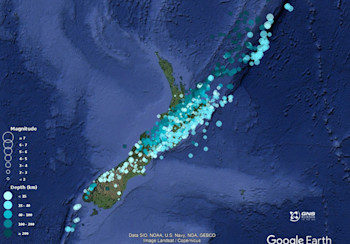
Small earthquakes, big insights
After a large earthquake, our team provide fast and accurate information to support emergency managers and decision makers so they can support communities impacted by the earthquake shaking. However large quakes are only a part of our monitoring efforts. In the background we keep a close eye on many small and often unfelt earthquakes which help us understand stress within the Earth’s crust and how we can all be better prepared for the large ones.
Counting quakes
While they may not be felt by people, smaller earthquakes play an essential part in our understanding of earthquake hazards and help us understand where large earthquakes come from. We use historic earthquake records dating back to 1815 to understand faults in the Earth and how they can compress, extend or transform tectonic plates. We add over 20,000 earthquakes each year to this earthquake catalogue — it’s a lot of essential data.
Understanding earthquakes and stress in the Earth
Earthquakes occur when stress builds up and that energy is released in the Earth's crust. The location, size, and frequency of earthquakes help us understand how much stress has built up in different areas and how easily it is being released.
Generally, in regions with few or only small earthquakes, we don’t expect large earthquakes to happen often. However, large earthquakes can still occur anywhere where stress builds up significantly over time, whether with earthquakes or not.
An example of this is the central Alpine Fault which doesn’t produce many small earthquakes despite being capable of hosting large ones. A lack of activity like this can be a warning sign, indicating that stress is silently building, rather than a sign that the fault is inactive. On the other hand, a fault can have lots of small earthquakes but still be building up stress to be released in a large earthquake.
Because of this complexity, our team look for patterns and trends in earthquake data to better understand the seismic hazard posed by faults.
How earthquakes reflect the complexity beneath the surface
On average we locate around 20,000 earthquakes each year around Aotearoa New Zealand and in the Kermadec region. Here the Pacific Plate and Australian Plate are pushing against each other, causing stress to build up in the rock. This stress is then released through movement in earthquakes.
In May we located 1,819 earthquakes in and around Aotearoa New Zealand and the Kermadec region, this is roughly what we expect to see each month. On the map below you can see these earthquakes occurring along a relatively straight line across Aotearoa New Zealand.
While that line of earthquakes may look like a straight line when viewed from space, inside the Earth it is more like a paint splatter. Around faults this ‘splatter’ of seismic activity is concentrated, while between faults, it’s more spread out. Each earthquake is a small rupture that helps accommodate the slow movement of tectonic plates. While some of this motion happens between faults, most of it occurs around and on the faults themselves — so that’s where most earthquakes happen.
By studying the shape and typical movement of individual faults, and how they relate to each other, scientists can model how large earthquakes might unfold. In a way, the ‘splatter’ pattern of small earthquakes gives us clues about what might happen when a major rupture occurs — like predicting the brushstroke from the splatter it leaves behind.
Watch: Animation to see how the plates interact below us
We can keep an eye on these earthquakes thanks to our national seismograph network — hundreds of instruments located across Aotearoa New Zealand to help rapidly identify and measure our earthquakes. Alongside this is our National Geohazards Monitoring Centre and expert science teams, which provides active monitoring of Aotearoa New Zealand’s geological hazards, 24 hours a day, 7 days a week.
We can’t prevent natural hazards, but we can, and should, be prepared for them
Remember Long or Strong, Get Gone: If you are near the coast, or a lake, and feel a strong earthquake that makes it hard to stand up OR a weak rolling earthquake that lasts a minute or more move immediately to the nearest high ground or as far inland as you can, out of tsunami evacuation zones.
For information on preparing for earthquakes or tsunami, there are guidelines from the National Emergency Management Agency's (NEMA) Get Ready website.
Prepare your home. Protect your whānau There’s a lot we can do to make our homes safer and stronger for earthquakes. Natural Hazards Commission Toka Tū Ake's website has key steps to get you started.


